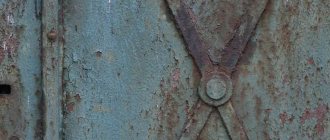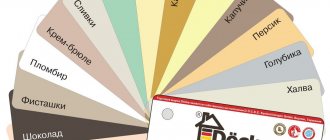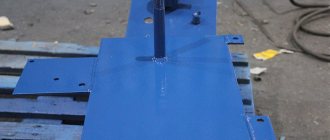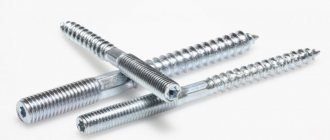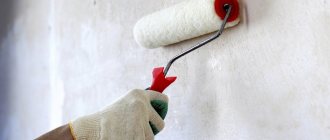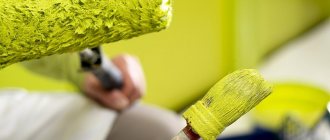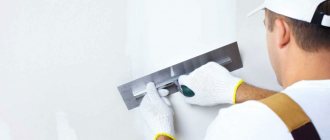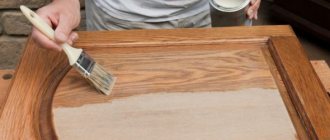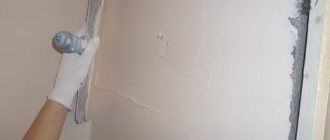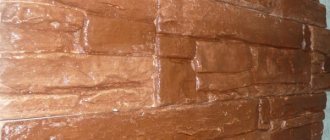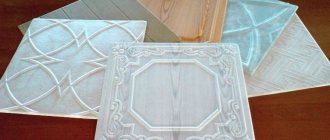Share on social media networks:
Recently, a relatively new type of finishing coating for walls and ceilings - fiberglass - has become increasingly popular among craftsmen. The building material is one of the best options for high-quality and durable interior decoration. With the help of a web you can avoid cracks on the surface of walls and ceilings. However, this material is not a finishing type coating; it is, so to speak, the basis for further finishing work. After gluing the web, many home craftsmen are faced with the problem of choosing paint and do not know whether it is possible to paint fiberglass without putty. Today we will try to help you understand the question of whether it is possible to paint fiberglass without putty; we will tell you which paints are best to use for the job.
Painting fiberglass: application
Do I need to putty or prime fiberglass before painting? The finishing material fiberglass is usually called gossamer and is used in reinforcing surfaces before finishing work. Cobweb is an excellent assistant in combating problems such as cracks on surfaces.
Important! The use of fiberglass virtually eliminates the possibility of cracks appearing on the walls and ceiling after completing the entire range of finishing works.
The web consists of fiberglass threads, like glass wallpaper, but the difference is that fiberglass is not made on machines, but is pressed using a method reminiscent of the paper-making process. As a result of such pressing, even, thin and smooth sheets with a fiberglass density of 25-50 g/sq.m appear.
Important! The material is quite smooth to the touch, although it can sometimes itch. Fiberglass is produced in 50-meter rolls. The strength of the web is relatively small, so any careless behavior with the material can lead to damage.
Fiberglass differs from glass wallpaper not only in the manufacturing method, but also in the lack of pattern and relief on the surface. This has its advantages, since the lack of relief on the surface of fiberglass allows it to be painted an unlimited number of times.
General information
Like glass wallpaper, fiberglass is made of fiberglass threads. Its difference from wallpaper is that it is not woven on a machine, but is pressed using a method reminiscent of the paper-making process. The result is smooth and even sheets with a density in the range of 25-50 grams per square meter.
This material is used not only because it allows you to quickly prepare walls or ceilings for painting, but also for a number of other reasons:
- Water resistance;
- Resistance to chemical reagents;
- The material does not accumulate static electricity, so it does not attract dust;
- Prevents the occurrence of fungus and mold;
- The fabrics allow air and steam to pass through well.
In the photo - fiberglass
In other words, fiberglass has the same properties as glass wallpaper. The only thing is that it does not have a pronounced texture, but for that reason it can be repainted many times.
pros
The undeniable advantages of modern finishing materials include the following:
- After proper gluing, the cobweb turns from a fragile and fragile sheet into a reinforcing mesh that can hide small defects in the surfaces of walls and ceilings.
- The material is practically not afraid of mechanical damage, exposure to water, fire and aggressive substances.
- Does not accumulate static electricity on the surface. Does not attract dust.
- The web contains only natural materials. Eco-friendly material does not emit substances harmful to humans into the air.
- Excellent air permeability.
- The material is non-allergenic.
- During operation, it allows water vapor to pass through well, thereby ensuring optimal humidity in the room.
- Fiberglass prevents the occurrence of fungus and mold.
Important! One of the main advantages of using fiberglass is the ability to apply paint to it almost immediately after gluing and drying. Since the cobweb has the same properties and features as glass wallpaper, the same paint and varnish coatings can be used for its finishing.
Recommendations for home crafters
In the process of decorating fiberglass, it is necessary to simultaneously paint the plumbing and heating systems. Communication pipes are often made of metal. Therefore, a composition with anti-corrosion properties is needed. For example, the electrically conductive Zinga CM is recommended.
It is recommended to strengthen the fixation of the canvas after gluing. The glue is diluted to a more liquid state. A mass of this consistency is applied on top of the canvas so that the sheet is saturated.
To the question whether it is possible to paint fiberglass without putty, the answer is yes, it is possible, but it is not recommended to ignore the preparatory work. It will take more paint and time to dry. Putty hides the texture of the canvas, which even 2 layers of dye cannot do. Puttying and priming the canvas is necessary. The strength of the entire foundation depends on this. The process is cheaper than simply plastering the walls and ceiling without working with fiberglass along with additional work. Leveling the surface with putty may not be necessary if a perfectly smooth coating is not needed. For example, in the back room, in the warehouse.
To glue fiberglass, you can use glue for glass wallpaper. They contain components that prevent the appearance of fungus. Dry glue is diluted strictly according to the instructions. Recommended adhesives: Bostik (Sweden), Wellton (Ukraine), Oscar (Ukraine), Pufas (Germany).
Latex paint creates a glossy finish.
Paint for fiberglass
How to paint fiberglass correctly? Experts recommend choosing water-dispersion paints, as they have the following advantages:
- Absolutely harmless to the human body.
- They are odorless as they are based on water and polymers.
- Can be used in any room.
- They do not change the properties of the canvas.
- Layers of paint lie smoothly, regardless of their number.
Most often, the following types of water-dispersion paints are used for painting fiberglass:
- Acrylic. Such paints are most popular because they have the following characteristics:
- Dries quickly.
- They have excellent adhesion.
- They are not afraid of moisture.
- Availability in terms of price.
- Possibility of obtaining almost any shade.
- Latex. The performance properties of latex paints are higher than acrylic ones, but they are more expensive. Advantages of the material: moisture resistance, durability, increased wear resistance.
Important! Unlike acrylic coatings, latex coatings can form a glossy surface.
- Silicone. This type of paint is the most expensive. However, silicone paints include all the positive qualities of acrylic and latex compositions and do not have the disadvantages. In addition, this type of paint has dirt-repellent properties, which allows you to wash painted surfaces much less frequently.
Preparing fiberglass for painting
The specificity of the fiberglass material is that it has a high degree of water absorption. In this regard, when painting, problems arise with high consumption of paint and varnish material, and painting difficulties are a separate issue. The fact is that when using water-based paints and varnishes, the fiberglass instantly draws water out of them, and the strip rolled with a roller immediately dries out, and the painter simply does not have time to roll it out in an even layer. To prevent such incidents from happening, they learned to prepare fiberglass for painting using the methods described below.
Excessive water absorption can be removed if, before painting the fiberglass, you treat it with either a deep penetration acrylic primer or a primer-paint from the line of purchased paints and varnishes. You can also take the paint and dilute it with water to such an extent that it becomes so fluid that it can penetrate into the smallest pores of the fiberglass. It is important not to saturate the material until it gets too wet, as is done when priming the putty layer (otherwise the glue will become soggy and the fiberglass will peel off from the wall surface). There is a second method of preparation, as for thin-layer decorative textures, described at the end of the article.
Many people recognize only one sensible way to paint fiberglass with modern paints - using types of rollers with medium pile. In this case, the paint is applied in a thick layer, but you need to try to stretch it, otherwise the layer will crack. It is enough to apply the paint in one layer if the fiberglass canvas has been pre-treated with primer-paint, but to “soften” its rough surface, it is better to apply a second, second layer.
How to paint fiberglass correctly?
Since the positive quality of the web is that it can be painted without preliminary or preparatory work, therefore, immediately after the canvas has dried, you can begin painting it.
Important! Of course, if you apply paint to fiberglass without putty, you can save time on drying the material that lines the walls. But in order to get a better finish, it is recommended to use putty before painting the canvas.
Why do you need putty?
Many professional builders give the following arguments in favor of using putty before painting the canvas:
- Putty will eliminate all defects and make the surface smoother and more perfect.
- The texture of the canvas is visible even under 1-2 layers of paint, which can ruin the appearance of the finish. The pores of fiberglass are very difficult to paint over. Only putty can eliminate the defect.
- Fiberglass absorbs paint perfectly, so its consumption without putty will be enormous. In addition, painting 2-5 layers will take a lot of time.
- If you decide to replace the paint with wallpaper over time, it will be almost impossible to do this on a surface without putty.
- When painting fiberglass, small fibers get into the air, which is unsafe for the human respiratory system. A surface treated with putty is not only easier to paint, but also safer.
Surface preparation
To carry out preparatory activities and make the surface ideal, be sure to proceed as follows:
- After the canvases glued to the wall have dried, apply a primer.
- Give the primer time to dry. This usually takes from 1 to 6 hours.
- Apply putty along each joint of the canvas in 2-3 layers. The layer thickness should be no more than 1 mm.
- To apply the final coat, use finishing compound. Apply putty to the entire surface of the wall (ceiling).
- Make sure that there are no gaps, irregularities or cracks left on the treated surface.
- Treat the surface with fine sandpaper or silicon mesh for cleaning, eliminating the slightest flaws.
- Treat the surface with a primer to improve paint adhesion and reduce paint consumption.
Important! To make sure that the canvas is prepared for painting, point a flashlight at the treated surface, and the beam of light will reveal all existing imperfections.
If you decide to paint the canvas without prior puttying, then to reduce paint consumption, prime it with glue. This will be much more profitable, since glue is cheaper than paint.
Painting fiberglass: step-by-step instructions
The process of painting cobwebs is not particularly different from painting other materials. To work you will need the following tools:
- Roller. It is better to use a filament-type nap roller.
Important! You can also use a paint brush for painting, but in this case the process of painting fiberglass will take a long time.
- Paint tray.
- Brush for painting hard-to-reach places.
- Oilcloth and masking tape.
After the base is leveled and treated with a primer, proceed to painting:
- Cover the floor with oilcloth, and protect surfaces that will not be painted from contamination with masking tape.
- Mix the coloring composition thoroughly until it has a homogeneous consistency. If desired, add a certain amount of color to the paint. To determine the proportions, first mix the components in a small container.
- Pour the prepared paint into the tray.
- Dip the roller into the paint. Squeeze out excess paint from the tool on a special area in the tray.
- Apply paint evenly from top to bottom onto the canvas.
- After the first layer has dried, apply a second coat of paint. The time between applying the next layer should be at least 12 hours.
- Touch up hard-to-reach areas with a brush.
- Wait for the paint to dry completely.
Important! When finishing canvas, you often have to deal with painting metal communications, in particular water and heating pipes. To finish these surfaces, use anti-corrosion compounds, such as Zinga conductive paint.
Preparation of fiberglass for decorative coatings
Decorative coatings, first of all, should be divided into thick-layer and thin-layer, since the preparation is carried out in completely different ways. In addition, the process of gluing fiberglass is slightly different: the glue is applied in a thick layer so that when smoothing the fiberglass, it seeps through. This achieves a high load-bearing capacity of fiberglass; the decorative layer under its own weight will not lead to peeling of the fiberglass covering from the wall.
Fiberglass for thick-layer decorative coatings , such as “Marseille wax” and other interior structures, does not require special preparation. Only the fiberglass is primed with primer-paints filled with quartz sand, possibly diluted with water in the proportion specified by the manufacturer. For application, use a brush or roller with medium bristles. If the fiberglass was glued in the “folk” way, that is, with putty, then before applying primer-paint it is treated with an acrylic fine-grained deep-penetration primer. You can read about this method in the “painting work” section, an article about materials for preventing cracks.
Fiberglass canvas for thin-layer decorative plasters and paints is prepared in such a way as to remove its relief structure. To do this, fiberglass is prepared for putty, then puttied with finishing acrylic painting compounds (as practice has shown, they have better adhesion and minimal shrinkage). If it was glued to putty, then it is primed with acrylic impregnations, otherwise no preparation is made. In order to putty fiberglass with high quality, you need to try to complete the work in one thin layer, not exceeding 2 mm in thickness. Then everything follows standard technology: sanding the dried layer and priming.
Summary of methods for preparing fiberglass for finishing coatings
Today, many are arguing about whether it is necessary to putty fiberglass - of course, this is the best way to prepare it not only for thin-layer decorative coatings, but also for ordinary background paints. Putty on fiberglass is especially helpful if the customer does not like the rough structure, which breaks through even after a layer of primer and two layers of paint.
There is a second alternative and debate about whether fiberglass should be primed, and many are inclined towards this surface preparation for painting and other types of finishing. Although the method is proven and reliable, it does not remove the texture of fiberglass, called the “web,” so you need to be aware of this nuance.
Source: mastery-of-building.org
How to glue glass wallpaper to drywall
Materials and tools
To hang fiberglass wallpaper you will need the following necessary tools:
- Roller
- Ladder - stepladder
- Scissors or construction knife
- Foam sponge
- Not very wide spatula for puttying
- Work clothes
- Latex gloves
It is not recommended to glue fiberglass wallpaper with wallpaper glue, since not every composition can withstand such a dense material. When choosing an adhesive composition for gluing glass wallpaper, use a high-quality product for special purposes.
If the surface is too porous and absorbs moisture well, you should add more water to the glue. To glue a canvas with an existing adhesive layer, it is moistened with water before use and then glued directly to the wall or ceiling.
Some mixtures contain additives that help increase the drying rate, increase the level of moisture resistance and protect against the appearance of fungus and other pathogenic microorganisms.
To obtain an effective decorative coating, you should figure out how to glue glass wallpaper onto drywall for painting. To work, you must wear protective gloves. This will prevent small particles of fiberglass from getting into your skin, causing itching and irritation.
The working process
- First you need to repair all the unevenness and prime the surface;
- Using a painting knife or scissors, cut strips with an allowance of up to 10 cm. This will allow you to correctly combine the pattern;
- Apply the adhesive to the walls or ceiling using a plastic spatula or roller. There is no need to smear the wallpaper;
- Lay the strips end to end, avoiding gaps and cracks. In order to correctly identify the wrong side of the material, the manufacturer has provided a special blue or gray stripe on it;
- Air and excess adhesive must be removed with a spatula and blotted with a sponge.
After gluing the wallpaper, you need to apply a solution of glue and water on top, which will help simplify the process of applying paint. Drying time for strips is on average 8-16 hours.
Advantages and disadvantages of cobwebs
Fiberglass is not without strengths and weaknesses in the same way as other colleague materials. Traditionally, people talk about the benefits first, so let’s move straight to their impressive list. Cobweb:
- it is considered environmentally friendly, absolutely safe, since it does not contain any harmful or suspicious components;
- sometimes it makes it possible to get by with only the starting putty, without the participation of the finishing type of this coating;
- is not noticed in the accumulation of static electricity, so dust ignores it;
- not afraid of high temperatures, temperature changes, or high humidity;
- durable, it is not afraid of mechanical stress, fire, corrosion;
- makes it possible to carry out work indoors and outdoors;
- it is vapor permeable, which means that mold does not threaten surfaces;
- and the adhesive composition for it do not provoke allergies;
- has no sharp unpleasant odors;
- does not require serious care.
The material can be safely glued to any surface - wood, concrete, brick, plasterboard, ceilings or walls.
There are also disadvantages, these include:
- The ability to “attack” low-quality, inexpensive material with a short service life. Such products will disappoint due to the inconvenience of working with them, inelasticity, and fragility.
- Impossibility of using first grade fiberglass in premises. It contains phenols and formaldehyde resins, which are undesirable components.
- The ineffectiveness of the material if there is a need to hide serious defects - large cracks, chips, potholes. They will have to be sealed in advance.
- The need for protection (gloves, glasses, masks, or better yet, a respirator) when working due to small glass particles.
- Difficult to dismantle the coating.
- High consumption of glue.
One cannot but agree that the disadvantages are still relative, since most of them relate to low-quality products. Therefore, in the “battle” of advantages and disadvantages, the first ones emerge as winners.
Workflow Description
We will look at several aspects, each of which is important in its own way, just read all the information so that you have a complete picture of the work ahead in your head.
Necessary materials
First we need to collect a whole list of materials that we will use. Below is a table that lists specific types of mixtures; I use them myself, so I can vouch for the quality and reliability.
Of course, there may be other options, the main thing is that they are of high quality, since even perfect adherence to technology will not allow you to do the job efficiently if you used low-quality components.
All formulations are of high quality and ease of use.
| Material | Description |
| putty | I use Vetonit compounds, as they apply just perfectly and rub off very easily. This type of dry mixes is ideal for beginning craftsmen; there are several composition options for different rooms; you must choose what is best suited for your conditions. As for the cost, the price is 400-450 rubles per bag weighing 25 kg |
| Primer | Where would we be without soil, because it is an indispensable attribute of any finishing work. The amount of composition depends on the chosen technology; below I will talk about the main aspects. The fact is that the composition can be applied once or twice, hence the required volume of primer also changes |
The soil allows you to strengthen the surface
I would like to mention another putty composition - “Shitrok”, it is sold in buckets in finished form, which increases the ease of use. I don’t recommend it only because of its high cost - a bucket weighing 28 kg will cost you about 1,200 rubles, but if costs are not important to you, take this option, as it is easier to use due to the fact that it does not need to be prepared before application.
"Shitrok" is another option that is popular among finishers
Selection of glue and paint
If the consumer wants to frequently change the color of the walls, it is advisable to choose more expensive jacquard wallpaper; on ordinary ones, after two or three repaintings, the patterns will merge, and the wall will present an unpleasant sight. It will seem that it is simply uneven.
Related article: How to paint on walls and with what paints?
An important point before starting work on gluing walls with glass wallpaper is the choice of glue. In addition to the fact that it must have good viscosity, high density and adhesion to both the wallpaper and the wall, the density of the selected wallpaper must be taken into account. After all, the denser, the heavier and the higher the quality of the glue should be. The composition should include, in addition to starch and PVA, components that prevent the formation of fungus.
The glue is usually produced in powder form, which requires dilution with water before gluing, but it is also sold ready-to-use.
It is better to choose water-dispersion paints; there should be a purpose on the can. Such compositions will paint fiberglass well and preserve the design. The paints are sold in white, and in a specialized store you can tint any shade, depending on the interior design of the color scheme of the walls in the apartment or house.
Wall preparation and gluing
It is assumed that before pasting the walls are leveled, primed, and puttyed. If you plan to glue fiberglass wallpaper after dismantling the old ones, it is necessary to carry out preparatory work:
1. First you need to clean the wall of old wallpaper, glue residues, knock down or clean with coarse sandpaper any protruding irregularities and crumbled remains of old putty.
2. Level the wall with putty, fill in all potholes and cracks, and reinforce with sickle if necessary. At the corners you can install paint corners where the web is glued.
3. After the putty has dried, sand the wall and check the flatness, sand if necessary. Be sure to let the putty dry before gluing.
4. It is good to prime the leveled wall with a regular primer or a thin layer of glue.
5. Before gluing glass wallpaper, prepare protective equipment to prevent harmful fibers and glass dust from getting into the eyes and respiratory tract.
6. Glue is applied to the wall along the entire plane of the width of the canvas, with a margin for good sizing of the joints. The wallpaper cut to size is glued from top to bottom, ironing it with a plastic spatula.
Article on the topic: How much paint is consumed per 1 m2 on facade plaster?
7. The canvases are joined without overlap, simply cutting the ornament to match the patterns. Carefully cut and cut holes for sockets and switches with a knife. After pasting, allow the wallpaper to dry for a couple of days, avoid drafts and temperature drops below room temperature.
As for the last, decorative stage, painting the fiberglass is done with two layers of paint using a paint roller. In order for fiberglass wallpaper to serve for a long time, all stages of the technological process must be carefully followed. When deciding to carry out the work yourself, you need to prepare all the tools and accessories so as not to spoil expensive materials.
